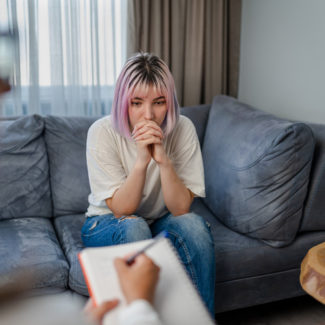We know that self-care is important for everyone. But how do you practice self-compassion and personal wellness when you have been through trauma or are trying to help someone through a traumatic life event? In the first part of a two-part series on trauma-specific self-care, we looked at how your body responds to stress and trauma and what individuals can do to begin healing. Now, in part two, we’ll explore how mental health professionals can take care of themselves while they take care of their clients.
How Does Treating Clients with Traumatic Experiences Affect Me?
The reality is that treating clients who have experienced trauma can have impact. This “inevitable secondary stress,” as Trauma expert and Simmons College Graduate School of Social Work professor Julia Colpitts, MSW, calls it, is natural. We evolved to connect with our pack to survive. When we see or hear other people’s trauma, the areas in our brain that are activated are the same ones that would be activated if it was primary trauma—our own trauma. Mirror neurons are engaged in the trauma’s retelling, and our bodies respond to the story and mimic the survivor’s physiological response. Trauma is, in a sense, contagious. So, what can we do about it?
What Is Secondary Stress?
“Vicarious or secondary stress is empathy in action,” Colpitts states, and it is unavoidable. We are social animals, and we respond naturally to others. The impact ranges from mild to clinically symptomatic, but all responses on the continuum can have a long-term effect. We can get stuck in arousal mode from the continuous retelling of traumatic life events if we don’t actively manage our secondary stress and its impact on us as therapists and mental health providers. It doesn’t have to lead to professional burnout; viewed and managed differently, it can even become an invitation to grow personally and professionally.
Secondary traumatic stress often causes muted arousal responses, either hyper (flood of anxiety, fear, and anger) or hypo (distancing from emotion). Over time, cognitive distortions can develop, altering one’s focus, the content of their thoughts, and even their worldview. Unacknowledged vicarious stress also has a negativity bias, which can obscure our compassion satisfaction and real accomplishments. For therapists who hear traumatic stories that resonate with their own prior life trauma, the arousal response can deepen—and our professional dissociation and burnout, historical and/or cultural trauma, and traumatized organizations can serve to further deepen that response.
Some mental health professionals, like others in the population, cope with secondary stress and trauma by employing short-term relief strategies to manage their state of arousal, such as food and alcohol issues, inactivity or “mindless” (dissociative) activities, and overwork. These primitive defense mechanisms may appear to help for a few hours, but ultimately they all have long-term negative consequences.
Unhealthy coping behaviors such as substance use may have the same effect as ignoring the secondary stress altogether: illness, including serious chronic conditions such as heart disease. Women who are social workers, for instance, are 36% more likely to have heart problems than women in other professions (American Heart Association scientific session, November 2019). And “community and social services” is number one of the top ten professions correlated to cardiac arrest (gender-neutral) (CDC Morbidity and Mortality Weekly Report, 2016). It is therefore crucial that we develop positive coping methods for secondary traumatic stress.
A therapist’s self-care involves acknowledging the continuous stress you are under and allowing yourself a release. We need to proactively prepare for secondhand stress and its impact on us through daily doses of calm interspersed through our days.
Which Tools Should Therapists Use for Secondary Stress?
How do we turn off the arousal response? We activate the care system.
“Self-care is not just what we do after work. Self-care is how we do the work itself.” –Julia Colpitts, MSW
First of all, guard against the tendency to overcommit, to overwork in an effort to soothe. Like the proverbial oxygen mask on an airplane, you are ill equipped to help others if you’re not functioning well yourself.
Then, create a resilience menu. Choose from an array of simple, self-care actions to calm the body and calm the mind—a personal relaxation practice that can radically reframe how you go about your day. As though you are selecting a dish from a restaurant menu, choose the one(s) that sound best to you that day, at that time. And just as we are advised to “eat the rainbow” when it comes to dietary health, your resiliency menu or toolkit works best when you layer soothing actions across the spectrum, and use self-care well not just when there’s a personal crisis, but proactively and intentionally, every day. Some examples of what relaxing options might be on your resiliency menu [link “resiliency menu” to October blog] include:
- Breathwork, such as box breathing
- Being kind to yourself—kick out the inner critic
- Muscle tension release using progressive relaxation techniques
- Guided meditation, such as those offered by Kristen Neff
- Sensory stimulation (e.g., aromatherapy, calming visuals, nature sounds, savory tastes, touch, water, sexual activity, massage, Reiki bodywork, and grounding strategies)
- Acupressure and acupuncture
- Yoga, tai chi, and other mind-body centering work
- Conjuring up images of love and connection
- Self-compassionate meditation and activities, such as bilateral stimulation like the butterfly hug, and affirmations
- Interacting with animals, including equine-facilitated therapy
- Mindfulness and related physical practices, such as walking meditation and forest bathing
- Body scans
- Expressing gratitude and love
Your resiliency tools not only help to heal the impact of secondary traumatic stress by releasing stored arousal responses and reestablishing a peaceful baseline, they also help strengthen your capacity for joy and presence and prepare you for future sources of stress.
How Can I Support Other Mental Health Professionals’ Well-being?
To journey to wellness together, we need to support positive attachments to ourselves, to others, and to community coregulation. As mental health providers, we can:
- Talk openly about secondary trauma and its impact.
- Add moments to meetings that emphasize compassion satisfaction.
- Practice personal relaxation techniques openly, as appropriate, to model calm.
- Notice and address when organizations are traumatized.
- Support setting realistic workloads.
Thank you to Julia Colpitts, MSW, for sharing her keynote presentation and ideas on this subject.
Sign Up To Receive Our Latest Blog Posts!
Learn more tips on living well and understanding mental illness. Help to end the stigma, and hear inspiring stories of recovery. Sign up here!










